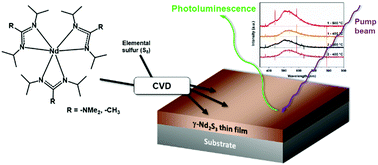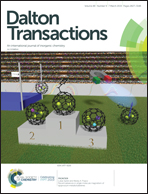Luminescent Nd2S3 thin films: a new chemical vapour deposition route towards rare-earth sulphides†
Abstract
Neodymium sulphide (Nd2S3) belongs to the exciting class of rare earth sulphides (RES) and is projected to have a serious potential in a wide spectrum of application either in pure form or as dopant. We demonstrate a facile and first growth of Nd2S3 thin films via metal–organic chemical vapour deposition (MOCVD) at moderate process conditions using two new Nd precursors, namely tris(N,N′-diisopropyl-2-dimethylamido-guanidinato)Nd(III) and tris(N,N′-diisopropyl-acetamidinato)Nd(III). The promising thermal properties and suitable reactivity of both Nd precursors towards elemental sulphur enabled the formation of high purity γ-Nd2S3. While the process temperature for film growth ranged from 400 °C to 600 °C, the films were crystalline above 500 °C. We also demonstrate that the as-deposited γ-Nd2S3 are luminescent, with the optical bandgap ranging from 2.3 eV to 2.5 eV. The process circumvents post-deposition treatments such as sulfurisation to fabricate the desired Nd2S3, which paves the way for large scale synthesis and also opens up new avenues for exploring the potential of this class of materials with properties for functional applications.



 Please wait while we load your content...
Please wait while we load your content...